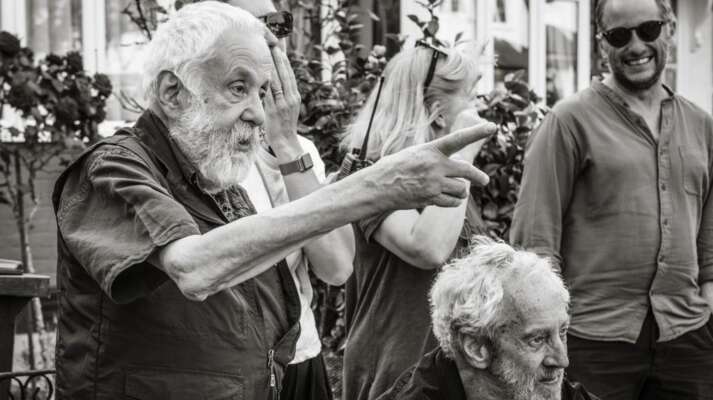The Intersection of Madness and Genius
The tortured minds of Bobby Fischer and others
The Intersection of Madness and Genius
Written by Peter Bowen
Bobby Fischer
Genius & Madness
“There is no great genius without some touch of madness,” observed Albert Einstein. For Bobby Fischer, whose genius emerged the moment he learned how to play from the instructions in a dime-store chess set, madness was not far behind. Many wonder if chess was not in fact an escape from the darkness inside him. “There is still something about Mr. Fischer’s craziness that is closely connected with the essential nature of chess,” wrote Edward Rothstein in a New York Times memorial. “The world itself, with its more messy human interactions, its complicated histories, its emotional conflicts, can be put aside, and attention focused on an intricate bounded cosmos.” In PAWN SACRIFICE, Tobey Maguire skillfully showcases the complex Rubik’s Cube of madness and genius that characterized Bobby Fischer as both a player and a man. During his early years, Fischer seemed to move between these two natures with a strange, elegant grace. His rants against the Soviet’s rigging the tournament system to keep their hegemony in tact turned out to be largely true. Even his quibbling, capricious demands over payment and venue were often considered brilliant psychological strategies rather than the quirks of a mentally fragile young man. But after beating Boris Spassky in 1972, Fischer’s eccentricities turned darker and more offensive. When he was no longer consumed by becoming a world champion, Fischer’s anti-Semitic and anti-American diatribes could not help but suggest a mind that had turned on itself. Like many other great minds plagued by mental illness before him, Fischer, while never losing his genius, became defined by his madness. “Despite the ugliness of his decline,” World Chess Champion Garry Kasparov reminds us, “Fischer deserves to be remembered for his chess and for what he did for chess…Bobby Fischer was one of a kind, his failings as banal as his chess was brilliant.”
Glenn Gould
The Odd Man In
In 1955, when the 23-year-old Canadian pianist Glenn Gould released his first record, Bach: The Goldberg Variations, the music world listened enthusiastically. Within months, this unknown pianist from Toronto reviving a little-played Bach study had become an international star and his album a runaway bestseller. Critics, like High Fidelity’s Roland Gelatt, applauded Gould: “His recording of the Goldberg Variations has managed to impress almost everyone who has heard it; the brilliance, understanding, and originality of his playing is not to be denied.” As audiences got to know Gould, his eccentricities could also not be denied. His odd behavior––wearing heavy overcoats and gloves in overheated rooms; humming and singing during performances; avoiding physical contact––became more pronounced when he started playing public halls around the world. At one point, some pundits championed his odd behavior as proof that he belonged to the emerging counter culture. “This young man is a magician,” exclaimed music critic Robert Sabin. “If he is to be dubbed eccentric, then my reply is that we need more eccentrics!” Throughout his 20s, Gould remained one of the most sought after concert pianists in the world. In 1957, at age 25, he was the first Canadian musician invited to perform in the USSR, where he was greeted with acclaim and sold-out houses. Despite such popularity, Gould abruptly retired from concert playing at age 31. From then till his death in 1982, Gould only played in his recording studio, performing not only classical music, but also creating a range of radio plays and audio programs. Away from the public eye, Gould, rather than disappear, only grew more mysterious and fascinating, as François Girard’s biopic Thirty-two Short Films About Glenn Gould so innovatively illustrates. While countless biographies and studies have attempted to fathom Gould’s strange behavior, they all agree on the power of his music. As the Cleveland Orchestra’s George Szell so succinctly quipped, “That nut’s a genius.”
Nikola Tesla
Unhinged Power
No figure better embodies the archetype of the mad scientist than Nicola Tesla. Born in Serbia in 1856, Tesla soon demonstrated both his brilliance and insanity. While at the Austrian Polytechnic in Graz, Tesla’s obsessive need to succeed so terrified his professors that they warned his father that his son was putting his life at risk through overwork. After moving to the US in 1884 to work for Thomas Edison, Tesla soon found himself competing against his mentor and boss. In the fight to establish electrical systems, Tesla’s plan for alternating current (AC) became the preferred (and safer) mode to Edison’s direct current (DC). Backed by Westinghouse and other corporate powerhouses, Tesla rose quickly to become one of the brightest and most inventive minds in America. His relentless curiosity and energy led to him receiving 212 patents for inventions in radio, remote control, radar and x-ray technology. But that same energy pushed him to embrace ideas that most considered outrageous, if not a bit insane. “One must be sane to think clearly,” Tesla said in his defense. “But one can think deeply and be quite insane.” His work on radio technology led him to build the Wardenclyffe Tower, a huge power station that would’ve used radio waves to transmit electricity. But before it was even half finished, the project was abandoned in 1906 when investors backed out, terrified by Tesla’s overblown predictions about his work. Often his projects sounded more like science fiction plots than new technology. His “Teleforce” death ray, he claimed, will be able to concentrate energy to “bring down a fleet of 10,000 enemy airplanes at a distance of 200 miles from a defending nation's border and will cause armies to drop dead in their tracks." He abandoned his own plans to develop an earthquake machine, fearing it might “split the Earth like an apple.” In the end, Tesla, once a genius as bright as Thomas Edison, died alone and impoverished in New York City.
Kurt Gödel
The Master of Uncertainty
If you were at Princeton in the 1940s, it’s likely you might have seen Albert Einstein and Kurt Gödel conversing in animated German as they walked to and from the Institute for Advanced Study. In fact, Einstein commented that he came to his office “just to have the privilege of walking home with Kurt Gödel.” Born in Czechoslovakia to an upper-class family, Gödel grew up an anxious, inquisitive child. Bearing the nickname Herr Warum (“Mr. Why”), Gödel’s innate curiosity took him to the University of Vienna, where at a young age he dazzled the math and philosophy faculty, earning his PhD at 23. Two years later, his incompleteness theorem dazzled the rest of the intellectual world. His proof that nothing can be proved was, according to his biographer Rebecca Goldstein, "the third leg, together with Heisenberg's uncertainty principle and Einstein's relativity, of that tripod of theoretical cataclysms that have been felt to force disturbances deep down in the foundations of the 'exact sciences.' " But as Gödel grew older, he began to suffer disturbances deep down in his own psyche. Partially exacerbated by the very real fear created by living in Vienna under Nazi occupation, Gödel’s youthful anxiety turned into deep paranoia after he immigrated to the US. Fearful of ghosts and terrified that people were trying to poison him, Gödel’s life grew increasingly small. To keep himself safe, he insisted his wife prepare and taste everything he ate. But when she grew ill and had to be hospitalized, Gödel’s paranoia caused him to starve himself. His death certificate in 1978 assigned "malnutrition and inanition caused by personality disturbance" as his cause of death.
John Nash
Lost in Mathematics
Now famous as the subject of Ron Howard’s 2002 Oscar-winning biopic A Beautiful Mind, the mathematician John Nash was for many years rendered nearly invisible by his schizophrenia. Born and raised in West Virginia’s Appalachian Mountains, Nash’s brilliance was recognized early on. Granted a scholarship to Carnegie Mellon University, Nash afterwards went on to Princeton’s graduate program in mathematics. Within two years, he’d completed a PhD and found a position at MIT. His doctoral thesis on game theory contained the groundbreaking work that would win him a Nobel Prize in Economics in 1994, nearly 44 years after he’d completed the work. However, what happened in those four decades between his PhD and his Nobel Prize is a troubling, tragic tale. Despite his meteoric academic career, Nash displayed problems early on dealing with others and the world at large. One Princeton colleague described him as "very brash, very boastful, very selfish, very egocentric.” “What redeemed him,” however, noted his friend Lloyd Shapley, “was a clear, logical, beautiful mind.” By age 30, just as MIT was about to grant him tenure, Nash’s beautiful mind unfortunately turned very dark. At first his behavior was just a series of bizarre antics––accusing others of stealing his ideas, hearing alien voices, announcing his plans to become the emperor of Antarctica––that his wife, Alicia Lopez-Harrison de Lardé, tried to cover up. But as he got worse, all semblance of normalcy had to be abandoned. His wife divorced him in 1963, although she continued to care for him. For years, he was in and out of mental hospitals, before his schizophrenia mysteriously abated in the 1990s. In later years, Nash looked back on his own madness with cool mathematical precision. In Sylvia Nasar’s biography, he calmly diagnosed his own hallucinations: “The ideas I had about supernatural beings came to me the same way that my mathematical ideas did. So I took them seriously.” For him, there was a strange logic that made both his genius and illness possible. “I would not dare to say that there is a direct relation between mathematics and madness,” he explained, “but there is no doubt that great mathematicians suffer from maniacal characteristics, delirium and symptoms of schizophrenia.”
Alan Turing
The Undecipherable Code Breaker
To illustrate the significance of choosing Alan Turing as one of the “100 Most Important People of the 20th century,” Time magazine observed “everyone who taps at a keyboard, opening a spreadsheet or a word-processing program, is working on an incarnation of a Turing machine." While the effects of Turing’s genius are there for all with a computer to see, the man himself has remained an enigma, even after Benedict Cumberbatch played the celebrated cryptographer in The Imitation Game. Historically, Turing’s obscurity was a consequence of the Official Secrets Act, which threatened him (or anyone who talked about him) with jail time for revealing his wartime work in creating the Enigma machine that broke the German code. And Turing’s homosexuality, which led to his arrest for gross indecency in 1952, and subsequent suicide two years later, no doubt kept the British government from recognizing his stunning achievements for several decades. But for many who knew him, Turing had been a mysterious genius from the start. His brother John remembered that no one “had the faintest idea that this tiresome, eccentric and obstinate small boy was a budding genius." At school, his teachers criticized him for paying too much attention to math and science, even though those studies paid off handsomely later when he was at Cambridge and Princeton University. But for the man who broke the unbreakable German Enigma, Turing had a terrible time figuring out basic social codes. Lyn Newman, the wife of one of Turing’s few friends, observed, “He was a strange man, who never felt at ease in any place. His efforts… to look like he felt a part of the middle upper class circles, which he naturally belonged to, were clumsy. He randomly adopted some conventions of his class, but rejected with no regret and hesitation most of their habits and ideas. And unfortunately the academic world's customs, which could have sheltered him, disconcerted and deeply bored him.”
Isaac Newton
Darkness in Light
When Isaac Newton died in 1727, the great poet Alexander Pope eulogized him with the epitaph, “Nature, and Nature's Laws lay hid in Night. / God said, 'Let Newton be!' and all was Light." But for the brilliant mind who ushered in modern science, there was not always light. During his greatest professional success, Newton was stricken with sudden fits of paranoia, delusion and depression. At Cambridge University, Newton, while a good student, didn’t even graduate with honors. But when the black plague closed his college, and Newton retreated home and into his own mind, his genius awoke. At his home at Woolsthorpe-by-Colsterworth at the age of 22, Newton established the basic work in the three fields of knowledge in which he would leave his most lasting mark––the practice of calculus, the nature of gravity, and the physics of optics and light. On his return to Cambridge, many of the faculty immediately recognized young Newton’s genius. The mathematician Isaac Barrow recommended Newton succeed him since he was “of an extraordinary genius and proficiency.” For the next few decades, Newton blazed a unique trail in physics and mathematics that culminated with the publication of his Principia Mathematica, a book that laid down the architecture of modern physics. In 1692, his light was briefly extinguished when he suffered a breakdown, during which he stopped sleeping and eating, and wrote crazed diatribes against friends and colleagues. He accused the philosopher John Locke of trying to "embroil" him with "women and other means.” So many friends received rambling, mad letters that London was filled with news of Newton’s lunacy. Within a few years, the depression lifted and Newton returned to his normal, remarkable, productive self. In trying to understand Newton’s incomprehensible madness, scholars have blamed exhaustion, strange religious practice and mercury poisoning. But they could no more account for Newton’s decline than the great scientist could fathom insanity. “I can calculate the motion of heavenly bodies,” Newton wrote, “but not the madness of people.”
Vincent Van Gogh
The Price of Genius
Vincent Van Gogh was all too painfully aware of the price of genius when he uttered, “I put my heart and my soul into my work, and have lost my mind in the process.” Unlike many others, Van Gogh’s genius was barely realized in his lifetime. Born into a middle-class Dutch family in 1853, Van Gogh was unexceptional in most things. But what he lacked in obvious talent he made up for in enthusiasm. Working at a London art gallery at age 20, he was fired for loudly dissuading customers from buying what he deemed “worthless art.” Five years later, the Church of Belgium refused to renew his contract as a minister caring for poor miners because they feared his extreme poverty and unhygienic habits were taking empathy a bit too far. With painting, Van Gogh found a vocation, which, if it didn’t completely keep his demons at bay, at least allowed him to channel his obsessions productively. Moving to the south of France, Van Gogh found in the area’s brilliant light and vibrant colors a catalyst for his genius. He wrote his brother Theo, “these canvases will tell you what I cannot say in words, that is, how healthy and invigorating I find the countryside." But even there, his productive periods were broken up by bouts of madness. After a terrible fight with his friend Paul Gauguin in 1888, Van Gogh had a breakdown, eventually cutting off his ear and leaving it with a local prostitute for safe keeping. Soon afterwards, the citizens of Arles, France, the town in which he tried to make his home, signed a petition condemning Van Gogh as dangerous. In 1890, a year after moving into Saint-Paul-de-Mausole asylum in Saint-Rémy-de-Provence, Van Gogh went out to paint one morning and shot himself in the chest.
Wolfgang Amadeus Mozart
The All Too Human Genius
In Milos Forman’s Oscar-winingAmadeus, based on Peter Shaffer’s play, Antonio Salieri (F. Murray Abraham) is a minor composer driven to vengeful insanity in seeing in Mozart (played by Tom Hulce) a genius inhabiting the body of a “boastful, lustful, smutty, infantile boy.” While much of the plot exaggerates historical facts, the film captures a fundamental truth about Mozart, that the composer’s erratic, often obscene, behavior was made all the more grotesque by the sheer majesty of his music. Mozart’s genius appeared early in his life. By six, Mozart was touring European capitals as a child prodigy, often showing off his precociousness by re-playing perfectly complicated scores that he had only heard once. By his early 20s, Mozart had moved to Vienna, where he quickly proved himself an unparalleled talent, composing remarkable symphonies, concertos and operas in quick succession. Yet despite his musical genius, his personal behavior and lifestyle created problems. His overspending kept him constantly on the brink of bankruptcy. Many found his scatological humor and odd personal tics, often grunting or making strange sounds in public, vulgar and offensive. And as he entered his 30s, he started to experience intense mood swings, with periods of dark depression followed by gusts of remarkable creativity. In 1791, obsessed with finishing his Requiem in D Minor, Mozart grew paranoid, insisting that his poor health was due to being poisoned. He supposedly told his wife Constanze, “I am sure that I have been poisoned. I cannot rid myself of this idea… Someone has given me acqua tofana [a local poison] and calculated the precise time of my death.”










